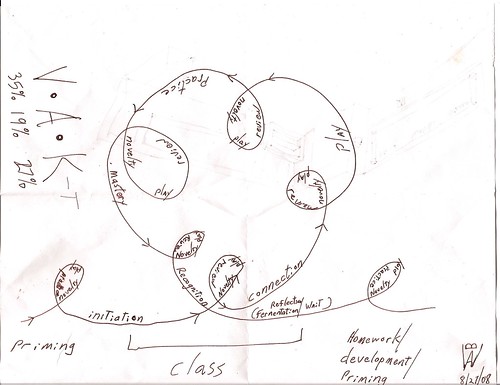
You sure do know a lot!
I'm rather thirsty for learning.
Amazing, how do you do that?
I only live once, I don't want to come back!
anselm23 said:
Two of the things I learned at the Learning & The Brain Conference at Avon Old Farms this year was the importance of learning cycles, and the value of face-to-face time. The brain takes in 4,000,000,000 bits of information per second through the sensorium of hearing, touch, taste, smell, sight, and kinetics.
The RAS processes this information (compresses it or filters it, we don't know) down to 2,0000 bps, and then the Amygdala analyzes it for stress or danger. If there's no stress or danger, the brain turns on its own reflective mode, and learning can occur, as the brain releases dopamine and seretonin, and a host of other neuro-chemicals to activate first working memory, and then long-term memory.
However, that cycle is short; you only have about 6-8 minutes of time before the neurotransmitters get re-absorbed and the mind begins to become bored. The only way to stimulate it is with a new burst of novelty that is neither stressful nor dangerous (to keep the Amygdala placated and happy).
Hence, the need to use Visual (V), Auditory (A) and Kinesthetic (K) methodologies to create novel, happy experiences so that the brain remains in a relaxed, happy, multisensory mode for a 40-minute period — the average length of a class at my school. Furthermore, there must be a priming — through homework, through classroom modification, through exposure to art, and through exposure to vocabulary — beginning a month to six weeks before the material is taught in the classroom.
Once in the classroom, this chart comes into play, quite literally. The priming feeds the cloud of energy that could/should occur in the classroom. Novelty initiates the first lesson, which encourages the students to learn by playing with, and then reviewing, a new concept every six-to-eight minutes. In a 40-minute class, this should happen 5-6 times. Furthermore, by combining this path of learning in the classroom with Ned Hallowell's FIVE STEPS of learning, any student (EVERY student) can in fact connect-play-practice-'master'-and-be-recognized in a 40-minute period. If I as the teacher am aware that the first 8-minute period is devoted to trying to get everyone to connect to the classroom's Daily Main Idea, then everyone should get connected. The second 8-minute period is about playing with a new concept or skill. The third is about practicing that new skill; the fourth is about working that skill to become much better at it. The last 8-minute period is about reviewing the day as a whole, and recognizing each student for what they have accomplished that day.
Then there follows a period of reflection or fermentation, where the student isn't in your class, but is interacting with and connecting to other ideas. The ideas bubble into long-term memory, and then have a chance to re-emerge during that night's homework. With luck, the ideas explored in class and in homework then are explored in dream that night — when we do a substantial part of the processing of information and data. Further, the homework ideally contains some element that primes the learning for a lesson in the next week, and the next month.
